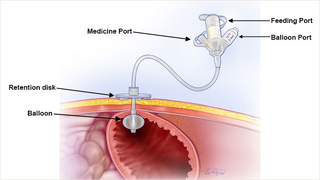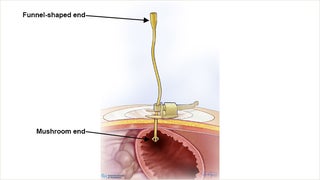Gastrostomy Tubes (G Tube)
What is a gastrostomy tube?
A gastrostomy tube, often called a G tube, is a surgically placed device used to give direct access to your child's stomach for supplemental feeding, hydration or medicine. G tubes are used for a variety of medical conditions, but the most common use is for feedings to enhance your child’s nutrition. When a child is unable to eat enough food by mouth, a G tube helps deliver enough calories and nutrients to support their growth.
Types of G tubes
Living with a G Tube
There are many different types of gastrostomy tubes that may be used to help your child. The type of tube selected depends on each patient's unique medical condition. Your child’s doctor will determine the best type of G tube for your child and explain this in detail at the time of the evaluation. Below are two of the most common types of G tubes to help you understand what to expect. Some names of tubes which may be placed include: AMT mini-one®, MIC®, MIC-Key®, and Cor-Pak®.
Living with a G tube
This series of instructional videos from CHOP is designed to prepare patients and families for what it is like to live with a G tube.
Low-profile tubes
One of the most common types of G tubes is a low-profile tube sometimes called a “button.” This type of tube lays on top of the abdominal wall and is kept in place in the stomach by a water-filled balloon. A special extension tube is attached when administering medicines or feedings. During your child’s hospital admission, you will learn how to use, clean and care for the G tube.

The above image shows a commonly used G tube called a low-profile button. This type of tube is placed surgically in the operating room. It creates a path to the stomach so nutrition and medicines can be administered directly. Most tubes have a water-filled balloon which helps keep the tube securely in place in the stomach.

This photo of a low-profile gastrostomy tube (button) shows how a well-fitting low-profile G tube will look after placement. The skin surrounding the button is healthy and intact.
At the base of the button is a balloon that is inflated once in the stomach. The inflated balloon helps secure the button in the stomach.
When placing the G tube, your child’s surgeon will determine the best way to attach the stomach to the inside of the abdominal wall. This allows for direct access to the stomach. Your surgeon will discuss this with you at your appointment before the G tube is placed.

Long tubes
Sometimes a longer tube is used instead of the low-profile button. These longer tubes are also surgically placed into the stomach and held in place with either stitches or a water-filled balloon.
For some long G tubes, a retention disc is pushed down along the outside of the tube. The disc rests against the skin of the belly. When the balloon and retention disc are in the correct position, the tube is held tightly in place.
This illustration shows a long tube with retention disc and balloon.

Another type of long tube is a mushroom gastrostomy tube. This is a latex tube with a mushroom-shaped end that is placed into the stomach. This tube is held into place with stitches and a Hollister® dressing. A Hollister dressing is a large circular dressing that allows the tube to stay in place with a ziplock-type device.
Some surgeons will place this type of tube initially, and once the tract (the opening from the skin) has healed, they will remove it and replace it with a low-profile gastrostomy tube, such as a G tube button.
This illustration shows the side view of a mushroom G tube in the stomach with a Hollister device.

If a long tube is the right choice for your child, we will teach you how to use and care for it. We will also show you how to keep it secure and change the dressing.
How is a G tube placed?
G tubes can be placed surgically in the operating room, or percutaneously, through a small incision, by a radiologist. Your child’s doctor will determine the best procedure for your child.
Surgically placed G tube
If a surgically placed tube is needed, it will be placed by a pediatric surgeon in the operating room. The surgeon will make one or more small incisions in the belly area, then make an opening into the stomach called a stoma. A tube will be placed through the belly opening and into the stomach.
Preparing for G tube surgery
You and your child will meet with one of the general surgeons at Children’s Hospital of Philadelphia (CHOP) for an appointment prior to G tube surgery. At this appointment, we will explain the details of the procedure and you’ll have a chance to ask questions and address any concerns. The procedure will then be scheduled for a later date.
Following surgery, all children will be admitted to the hospital for a few days to safely begin feedings. During this admission, you will be taught how to care for the G tube, including how to administer feedings, how to clean and care for the stoma, and how to apply a gauze dressing if needed.
Follow-up after G tube surgery
Your child will be seen for an appointment with general surgery about four to six weeks after being discharged from the hospital. In many instances, the G tube will be changed at this appointment. Additional follow-ups will be scheduled, if needed.
Percutaneous gastrostomy tube placement
A percutaneous gastrostomy tube is another type of G tube. A radiologist usually performs this type of tube placement in the Interventional Radiology while your child is asleep. Find more information on this type of tube.
When to call your doctor
Although G tubes are generally easy to use without much maintenance, there are some potential problems your child may experience. If you have any concerns about your child’s G tube, please call us immediately. We can discuss whether your child should be seen in our clinic or if they require immediate, emergency medical attention.
Dislodgement
Most tubes are secured by a balloon inside the abdomen or by stitches, but they can still become dislodged or removed from the stomach. If this happens before your first follow-up appointment, please call your child’s surgeon immediately. If this happens after your first change, a parent/caregiver or trained professional can replace the G tube. If you have concerns about dislodgement of your child's tube, please call your child’s surgeon.
Leaking
Leaking around a G tube is common. You will learn how to apply a dressing under the tube, like a piece of gauze, in case the G tube leaks. Sometimes the drainage becomes excessive and will soak the dressing very quickly. If this is the case, call your child’s surgeon or pediatrician to make an appointment to have your child's G tube evaluated.
Granulation tissue
Granulation tissue is typically dark pink or red and is the body’s natural response to the tube. This tissue may cause some leakage and irritation around your child’s G tube site. Granulation tissue can be treated with topical steroid creams or with cauterization with silver nitrate. If you have a concern about granulation tissue, call your child’s care team to discuss and to determine whether your child needs an appointment for an evaluation.
Reviewed by: Surgical Advanced Practice Nurses
Date: July 2023